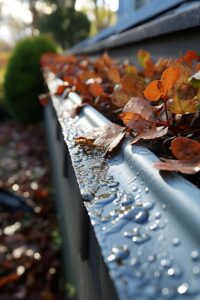Foam gutter guards are protective inserts made from a special foam material designed to fit directly into your gutters. The purpose of these guards is to prevent debris, such as leaves and twigs, from entering and clogging the gutters while still allowing rainwater to flow freely.
The foam’s porous structure ensures that water can pass through. Still, larger debris remains on top and eventually blows away or decomposes.
For Mornington Peninsula residents where seasonal debris can be an issue in their homes, these foam inserts can be a cost-effective solution from your gutter cleaning provider.
In this blog, we’ll discuss everything you need to know about foam gutter guards for your home.
What Are the Advantages of Using Foam Gutter Guards?
The following are the advantages of using foam gutter guards:
Easy Installation
One of the primary advantages of foam gutter guards is their ease of installation. Unlike other types of gutter protection systems, foam guards typically don’t require screws, nails, or professional expertise. Homeowners can often fit them into their gutters by simply pushing the foam into place.
Prevents Small and Large Debris Accumulation
While many gutter guards are effective at keeping out larger debris like leaves on roof, they might struggle with smaller particles like pine needles and seeds. With their porous design, foam gutter guards can prevent large and small debris from entering the gutters.
Cost-Effective Solution
Foam gutter guards are generally more affordable than other types of gutter protection systems, such as metal or mesh guards. Their straightforward design and materials mean that they are a cost-effective solution for homeowners who want to protect their gutters from debris without incurring a significant expense.

What Are the Disadvantages of Using Foam Gutter Guards?
Here are the disadvantages of using foam gutter guards:
Limited Lifespan
Due to their material composition, foam gutter guards tend to have a shorter lifespan compared to metal or mesh alternatives. Over time, the foam can deteriorate because of exposure to the elements, such as UV rays, extreme temperatures, and frequent moisture. This degradation means homeowners might need to replace them more frequently than other gutter guards.
Potential for Organic Growth
The porous nature of foam makes it a potential site for moss, mould, and algae growth, especially if the foam remains damp for extended periods. This can not only reduce the efficiency of the guard but also introduce organic debris into the gutter system. Homeowners will need to periodically check and possibly clean the foam inserts to ensure they remain free from such growths.
Inadequate Handling of Heavy Rainfall
During heavy rain, foam gutter guards can sometimes struggle to handle the volume of water, causing overflow. The foam’s porosity might not be sufficient to let vast amounts of water through quickly, especially if some of the pores are clogged with debris or organic growth. This overflow can lead to potential water damage to the property, especially if it’s a recurrent issue.

Are Foam Gutter Guards Worth It?
Foam gutter guards are worth it because they offer easy installation and are cost-effective initially. They are appealing to homeowners who need to install gutter guards immediately.
However, it’s important to remember their limited lifespan and potential for organic growth and clogging when it rains hard.
